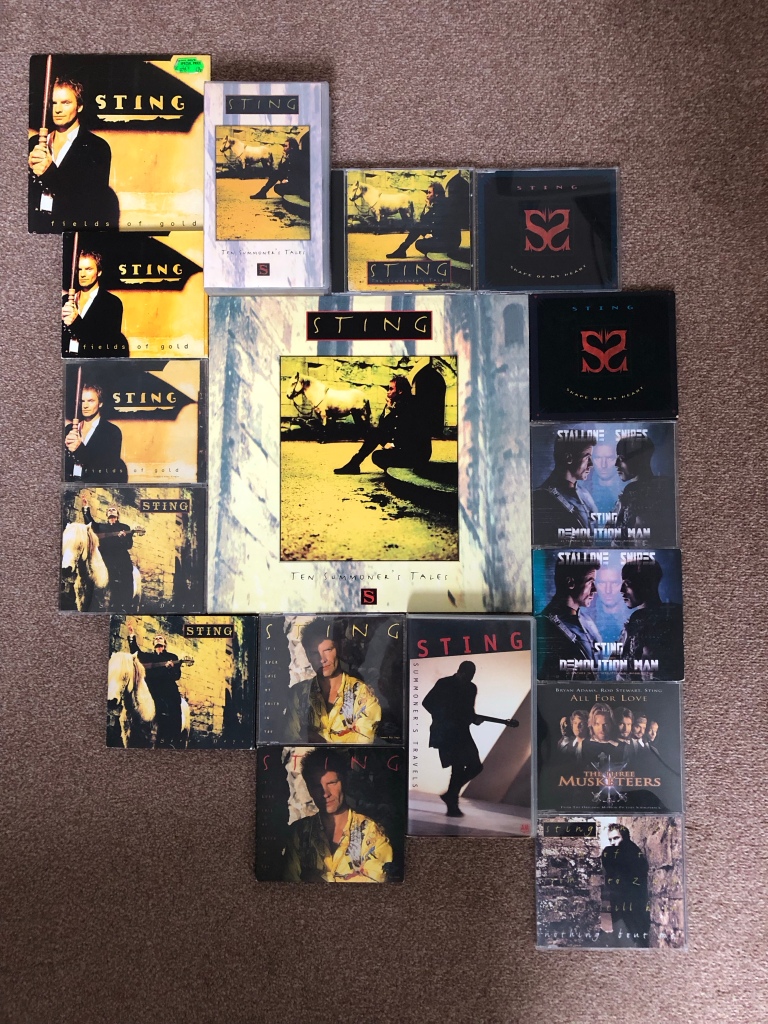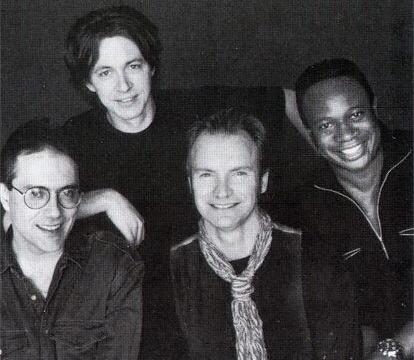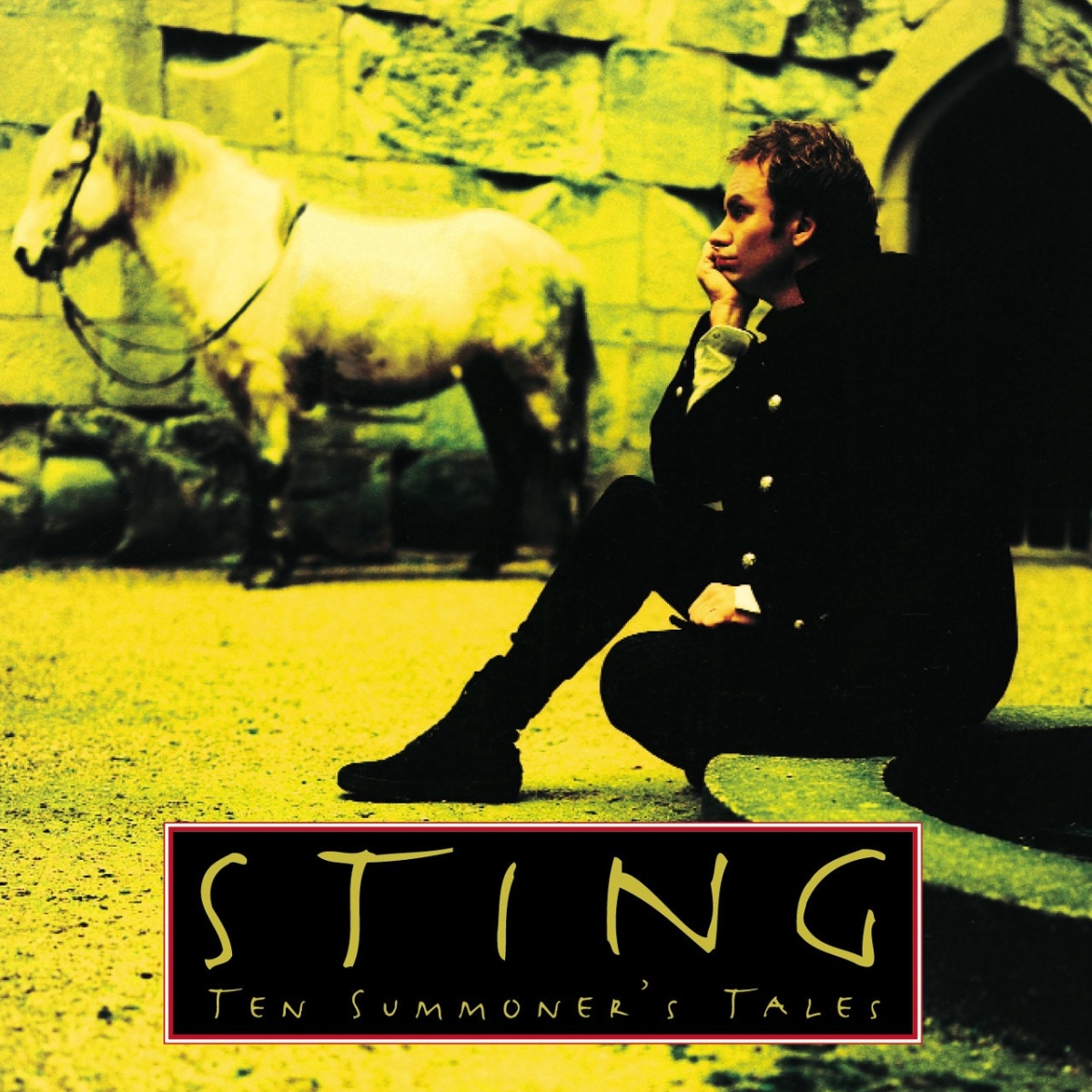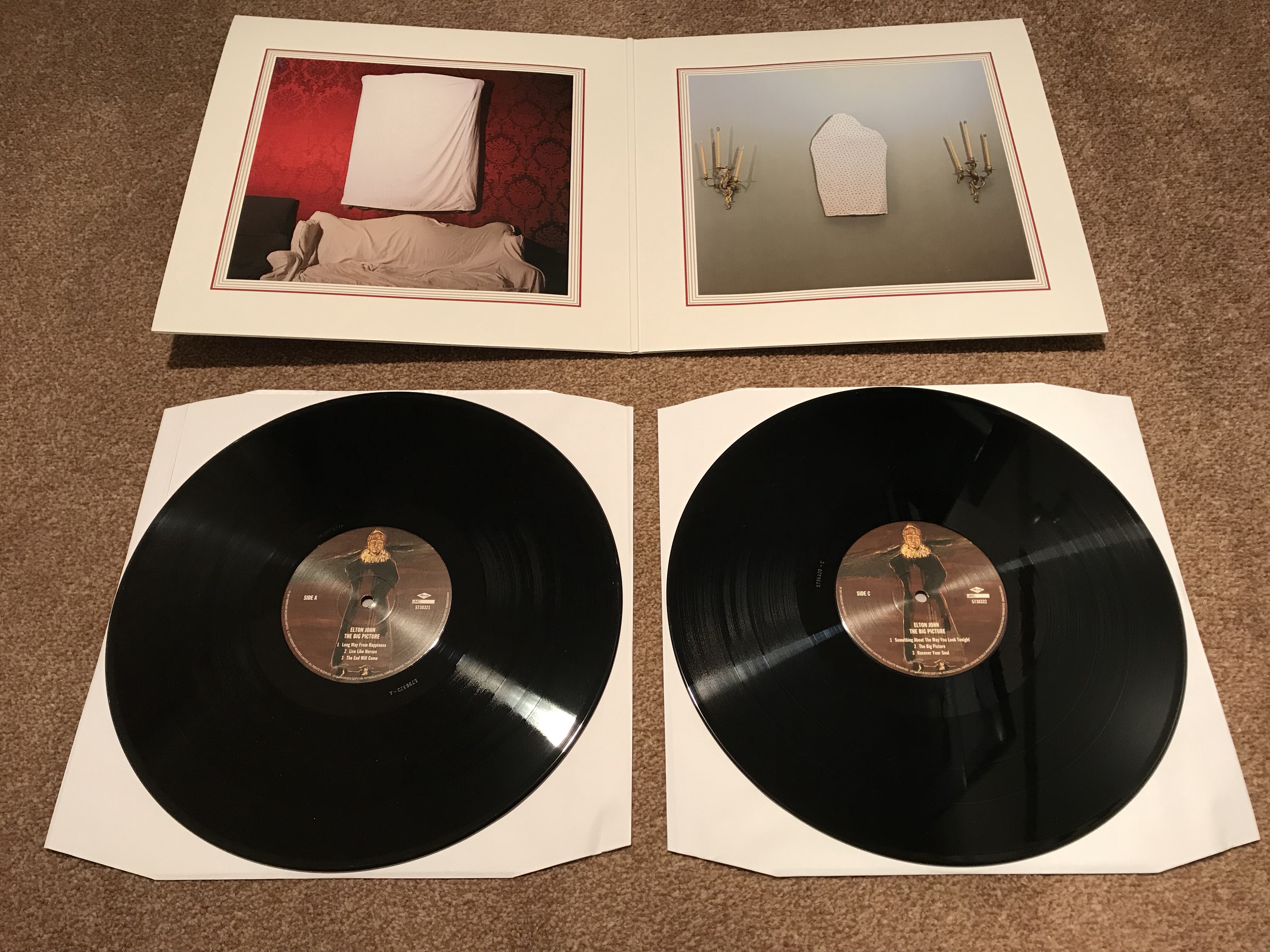Sting’s 1991 album The Soul Cages had resulted from a great deal of soul-searching. Having lost both of his parents within a short space of time, Sting found himself in a period of writer’s block. The answer, as it turned out, was to look back to his roots in Newcastle-upon-Tyne. The resulting album was a dark, brooding and often thought-provoking affair which, conversely, is considered by many fans to be amongst his best work.
Subsequently, in 1992, Sting moved out to the English countryside. Lake House, an Elizabethan property dating back to 1578 near Amesbury in Wiltshire, would become his main home base for much of the remainder of that decade. Now married to long-term partner Trudie Styler and with a young family, Sting was in a good place.
And quite apart from his newly found domestic bliss, he also had a good, steady band to work with. A streamlined four-piece formed during 1990 for the tour behind The Soul Cages, it consisted of Sting himself of bass and vocals, Dominic Miller on guitars, David Sancious on keyboards and Vinnie Colaiuta on drums. A formidable combination of talents to say the least, they became as tight a unit as Sting has ever assembled. The ground was laid, then, for Sting to set about writing and recording his next album with renewed fervour.
With many a ghost exorcised by The Soul Cages and a killer band to write for, Sting now felt the freedom to simply write songs for enjoyment, in any kind of style and in any kind of mood. The result was Ten Summoner’s Tales, an instant classic regarded by many to be his finest work – perhaps even his definitive album as a solo artist.
It was in many respects the antithesis of The Soul Cages. Where its predecessor had been dark and deep, Ten Summoner’s Tales was light-hearted and jubilant. As Sting himself said in a Q Magazine interview at the time:
“Do I have to f****** slash my wrists every time I want to write a song? Having done it on Soul Cages…I didn’t want to excavate another trauma, I just wanted to write songs for fun.”
Even the album title is somewhat tongue-in-cheek. The album is named Ten Summoner’s Tales, but in fact contains twelve songs, not ten. It is also, of course, a reference to Geoffrey Chaucer’s Canterbury Tales as well as Sting’s own surname of Sumner.
The album artwork design was laid back too. The front cover shows Sting sat in what was once the main hall of Old Wardour Castle, a ruin in Wiltshire owned by English Heritage. An Icelandic horse owned by Sting at the time stands in the background. I have visited the site myself and if you want somewhere peaceful to visit, away from life’s general hustle and bustle, I can highly recommend it. I have, naturally, attempted to emulate the front cover of the album, though I had a bit of trouble sourcing an Icelandic horse for my own take on the photo.

Another significant aspect that brought such a relaxed feel to Ten Summoner’s Tales was the location of its recording. The bulk of the album was laid down at Lake House. This was the first album Sting recorded at home. He has often spoken of how the atmosphere of the house and its location somehow feeds into the mood of the finished recording. There can be no doubt that making this album in the English countryside had an impact on the music and is very possibly a part of what made the album so likeable. As keyboardist David Sancious has commented many years since, Ten Summoner’s Tales has remained among his favourite recording session memories:
“Ten Summoner’s Tales was an amazing project. The atmosphere at Lake House was great. We worked really hard, but we also had a great time making the record.”
Such was the impact of Lake House on Ten Summoner’s Tales, that the album was also shot in video form. The VHS video (yes, it really WAS that long ago), which to this day has sadly never seen a reissue, was filmed in the room where the album had been recorded and features live performances by Sting and the band of all but one song from the album, some of which have the live sound of the on-screen performances whilst others are overdubbed with the original album versions. And, in case anyone from Stingland happens to be reading this, can I just put my request in here for a fully restored and expanded Blu-ray reissue of this film? Thank you kindly in advance.

‘If I Ever Lose My Faith in You’ served as both the lead single and opener on the album. Deliberately placed to start the album abruptly without any fanfare or build-up, the record hits the ground running with a song that has become one of Sting’s most widely recognised compositions. Placed over an elastic drum pattern provided by Vinnie Colaiuta, it breaks into an instantly memorable chorus with an ascending melody that is perhaps among the most uplifting Sting has ever written. It also proved an effective set opener throughout the subsequent world tour. ‘Love is Stronger Than Justice’ follows, effortlessly switching between a 7/4 meter in the verses and a 4/4, country-flavoured chorus. The song features pedal steel maestro Paul Franklin who had recently recorded and toured with Dire Straits, plus an outstanding piano solo from David Sancious over one of Sting’s many simple but extremely effective bass riffs, taking us into the fade-out. The outro of the song proved to be an excellent, semi-improvised work-out for the band on the tour, demonstrating the remarkable musical synergy that existed between the four musicians on stage.

L-R: Vinnie Colaiuta, Dominic Miller, Sting, David Sancious
What follows is, arguably, the most recognised and widely beloved song of Sting’s solo career. ‘Fields of Gold’ has become somewhat of a standard. Every aspect of the writing and recording of this song comes together to create something rather special. An achingly gorgeous ballad, it was inspired by the sight of the barley fields surrounding Sting’s home which, at that particular time of the year, had a distinct golden hew as the wind gently arched them back and forth. It is not an over-complicated song. It has a relatively simple melody and chord structure, the drum pattern remains largely unvaried throughout, as does the instrumentation. But there is just something about the way in which it was recorded – the performances by the band (including a not insignificant contribution by legendary Northumbrian piper Kathryn Tickell) and the way Sting delivers his vocal – it is simply perfect. And that is perhaps the art of writing a great song. It doesn’t have to be massively complicated. The simplest creative ideas and approaches to arrangement can often be the most effective and that is most certainly the case with ‘Fields of Gold’.
But we are only on the third track! Yet more classics follow. The funky ’Heavy Cloud No Rain’, a song essentially about sexual frustration disguised as a one about a farmer lamenting a lack of rain, features another of Sting’s trademark bass riffs and a superb slide guitar solo break by Dominic Miller. Sting’s take on a kind of rockabilly shuffle, ’She’s Too Good for Me’ follows with two bass lines walking back and forth over one another.
‘Seven Days’ is a prime example of Sting’s ability to write songs in unusual time signatures and make them sound completely seamless. Often, a song in 5/4 will sound angular and unusual to the ear, but ‘Seven Days’ sounds completely natural, and of course Sting is helped in no small way by a band who can play in odd meters as if it is second nature to them. Indeed, this song works so well that it was released as the second single from the album, such is its instantly memorable chorus. The live version became somewhat of a tour-de-force for Vinnie Colaiuta who would go all-out on the drum fill before the last chorus. More fun with odd time signatures follows with ‘Saint Augustine in Hell’, featuring sinister narration by David Foxxe and a chorus with two competing lead vocal melodies. We then have an alternative version of ‘It’s Probably Me’, originally written for the Lethal Weapon 3 soundtrack and released the previous year. The Ten Summoner’s Tales version has a completely different arrangement which, in Sting’s own words, gave the song a more ‘nocturnal’ edge.
Moving into the final third of the album, we find ‘Everybody Laughed But You’. This song was not originally included on the vinyl edition or US releases, where it was issued as a B-side. Interestingly, Sting wrote two different songs over this same backing track. The other is called ‘January Stars’ and was released as a B-side on the ‘Seven Days’ single.
We then have another widely recognised song in ‘Shape of My Heart’, a co-written effort between Sting and guitarist Dominic Miller. Dominic had arrived at the studio one day with a guitar riff that he had made up, mostly as a finger picking exercise. Sting heard this, liked it and recognised the potential for it to be expanded into a song. So Sting and Dominic experimented with it, structured it and Sting then took a walk in his garden, returning with some lyrics which subtly touch on the subject of songwriting itself, using the analogy of a gambler dealing a pack of cards. Dominic jokingly claims he must have found those lyrics under a stone somewhere. Whatever the case, ‘Shape of My Heart’, though it originally failed to make the UK top 40, gradually became one of Sting’s biggest hits, partly through its use by numerous acts (intriguingly many of whom from the contemporary R&B genre) as a sample for creations of their own. The original is also notable for a beautiful harmonica solo played by the late, great Larry Adler. Numerous instruments had been experimented with, but the choice of Larry Adler to play that solo was an inspired one. It could not have been a better fit.
‘Something the Boy Said’ is the penultimate track and being such a strong song, is well placed here. It has another of Sting’s classic trademark bass hooks, and with sublime guitar and keyboard parts played by Dominic Miller and David Sancious, it is brilliantly atmospheric. Its lyrics paint some strikingly macabre imagery: “When I awoke this morning // The Sun’s eye was as red as blood // The stench of burning corpses // And faces in the mud”. It is superbly written, arranged and engineered. Finally, we finish with the fifth and final single, ‘Nothing ‘Bout Me’. Clearly designed to close out the album, the outro develops into an ascending chord sequence which repeats over and over with a crescendo of strings continuing through a slow fade-out. In Sting’s words, it was a way of saying “Well, these are the songs…but you still know nothing ‘bout me!”. It is a triumphant end to an outstanding album.
Ten Summoner’s Tales is widely considered to represent Sting at his absolute best. It is packed with classics from end to end, never dropping the ball at any moment. It shows Sting at a creative peak, enjoying the process of writing his songs, presenting them to the band and recording them, before finally taking them out on the road. He had an absolutely top-drawer band to help bring the songs to life, and he also had a legendary co-producer in Hugh Padgham during this period of his career. Together, they clearly knew how to get the best out of the songs. The production was tight and polished, but neither was it over-egged at one extreme or undercooked at the other. It had the distinct feeling of a band playing together, and partly thanks to the nature of the recording location, the sound had space and room to breathe. It has an organic sound that is so lacking in chart music today. But the crucial element is that the music has a timeless quality. Ten Summoner’s Tales is an album that could be written and recorded now in exactly the same way, with precisely the same artistic choices made. It would not sound dated or out of place. As I write this appreciation of one of my personal all-time favourite albums, Ten Summoner’s Tales is celebrating the 30th anniversary of its original release. It is as great and vital an album in 2023 as it ever was.






